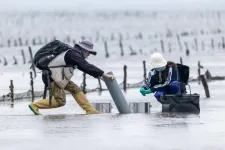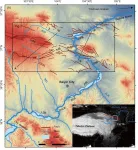Research uncovers how 'non-professional' cells can trigger immune response
Worm cells sense changes in metabolism to activate defensive measures against pathogens
2021-05-26
(Press-News.org) Included in the vast fallout stemming from the COVID-19 pandemic, scientists are paying closer attention to microbial infections and how life forms defend against attacks from pathogens.
Research led by University of California San Diego scientists has shed new light on the complex dynamics involved in how organisms sense that an infection is taking place.
UC San Diego Assistant Project Scientist Eillen Tecle in Professor Emily Troemel's laboratory (Division of Biological Sciences) led research focusing on how cells that are not part of the conventional immune system respond to infections when pathogens attack. Scientists have conducted extensive research on so-called "professional" immune cells that are defensive specialists. Much less is known about how "non-professional" cells handle such threats.
Tecle, Troemel and their colleagues at Pennsylvania State University focused their research on roundworms (Caenorhabditis elegans), animals that lack dedicated immune cells, to help decipher details of such dynamics.
As described in the journal PLOS Pathogens, the researchers conducted experiments involving roundworms under attack by viruses and microsporidia, which are natural pathogens of worms and humans. The results indicate that roundworms may sense changes in their metabolism in order to unleash protective defenses, even if they don't directly sense the pathogen incursion.
In their study, the researchers examined how hosts may respond when pathogens such as viruses and microsporidia steal key compounds from C. elegans cells known as nucleotides. Pathogens like these are required to pilfer such components from their hosts in order to survive. The study's results focused on biological pathways related to the breakdown of chemical compounds known as purine nucleotides. This purine metabolism pathway is key to the cells' ability to sense alterations as a way to induce an immune response.
"We hypothesize that the host has ways to surveil what's going on inside of its cells in an active process," said Tecle. "Our results suggest that the host has developed ways to sense the theft of purine metabolites. It seems that when these key cellular building blocks are stolen by the pathogen, the host senses this theft to mount an immune response to the pathogen."
This research may shed light on why purine-related compound mutations have been found to underlie many human diseases, including adenosine deaminase deficiency, which damages the immune system, and Lesch-Nyhan syndrome, which involves neurological and behavioral abnormalities. While these mutations result in various disorders in humans, they may persist in the human population to provide some protection against infections, for example during viral pandemics.
"Particularly in the context of the COVID-19 pandemic, it's so important that we continue to study these questions of immunity in lots of different systems to build new tools so that we can learn how to prevent and treat infections," said Troemel.
INFORMATION:
The authors included: Eillen Tecle, Crystal Chhan, Latisha Franklin, Ryan Underwood, Wendy Hanna-Rose and Emily Troemel.
[Attachments] See images for this press release:

ELSE PRESS RELEASES FROM THIS DATE:
2021-05-26
Alzheimer's disease - also called dementia - where memory and cognitive functions gradually decline due to deformation and death of neurons, and Parkinson's disease that causes tremors in hands and arms impeding normal movement are major neurodegenerative diseases. Recently, a research team at POSTECH has identified the structure of the agent that causes Alzheimer's and Parkinson's diseases to occur together.
A research team led by Professor Joon Won Park and Ph.D. candidate Eun Ji Shin of the Department of Chemistry at POSTECH investigated the surface structure of hetero-oligomers found in the overlap of Alzheimer's disease and Parkinson's disease, using an atomic force microscopy (AFM) to reveal their structural identity. This study was featured as the ...
2021-05-26
While the plates carry water to the Earth's interior, phase transitions of dry olivine, the main mineral in the plates, are thought to be responsible for deep-focus earthquakes and plate deformation. This study resolves the contradiction of the presence of dry olivine even in wet plates. Takayuki Ishii, a researcher at the Center for High Pressure Science & Technology Advanced Research (HPSTAR), China and the Bavarian Institute of Geosciences, University of Bayreuth, Germany, and Eiji Otani, a professor emeritus at Tohoku University, used high-pressure and high-temperature experiments to determine the water content of olivine under ...
2021-05-26
Tiny charged electrons and protons which can damage satellites and alter the ozone have revealed some of their mysteries to University of Otago scientists.
In a study, published in Geophysical Research Letters, the group looked at charged particles interacting with a type of radio wave called 'EMIC' - a wave generated in Earth's radiation belts (invisible rings of charged particles orbiting the Earth).
Lead author Dr Aaron Hendry, of the Department of Physics, says it is important to understand how these waves affect the belts - which are filled with expensive and important satellites - and Earth's climate.
"Much like the Earth's atmosphere, the Earth's magnetosphere - the region around the Earth where our magnetic field is stronger ...
2021-05-26
A new study from the University of Kent, Toulouse Business School, ESSCA School of Management (Paris) and ESADE Business School (Spain) has revealed the three primary risks and benefits perceived by consumers towards autonomous vehicles (self-driving cars).
The increased development of autonomous vehicles worldwide inspired the researchers to uncover how consumers feel towards the growing market, particularly in areas that dissuade them from purchasing, to understand the challenges of marketing the product. The following perceptions, gained through qualitative interviews and ...
2021-05-26
There is growing evidence that house design can decrease the force of malaria infection.
The world's most deadly assassin is Africa's malaria mosquito: Anopheles gambiae. In 2019, the World Health Organisation estimated that malaria killed 386,000 people in sub-Saharan Africa, mainly children.
Whilst we think of the home as a sanctuary, in Africa, around 80% of the malaria bites occur indoors at night. Preventing mosquitoes from getting indoors is a simple way of protecting people from this often lethal disease.
As most mosquitoes fly low to the ground, a team of researchers led by Durham University wondered whether ...
2021-05-26
Fishery and aquaculture have given rise to an enormous uniformity in the diversity of bivalves along the more than 18,000 kilometer long Chinese coast, biologist He-Bo Peng and colleagues report in this month's issue of Diversity and Distributions.
Climate zones
Peng and colleagues sampled bivalves at 21 sites along the Chinese coast from the city of Dongliaodao in the tropical south, to the mudflats of Yalu Jiang, more than 2000 km further north and ice-covered for several months in winter. "At 19 out of these 21 sites, commercially exploited species dominated", Peng saw. "In the naturally occurring species, we still recognized the natural gradient with highest diversity in the tropics and lowest diversity in ...
2021-05-26
The Manchester Arena terrorist bomb attack in 2017 exposed flaws in the response of emergency services that could be addressed with a new three-phase approach, research by the University of Bath School of Management shows.
Current government guidelines outline a two-phase structure of 'response and recovery', which researchers discovered hampered effective communication between agencies, created over-reliance on centralised Police decision-making, and inhibited other services' ability to take initiative earlier in an emergency.
"To better prepare responders for emergencies we recommend a three?phase structure of 'response/resolve/recovery' is introduced in place of the current guidelines ...
2021-05-26
Skeletal muscle is the largest organ in the body that accounts for 30 to 40% of body weight and is responsible for multiple functions such as energy metabolism and heat production. However, skeletal muscle mass is reduced in some diabetics, and that muscle loss correlates with mortality. It has been reported that the differentiation of myoblasts, which are the muscle precursor cells, is reduced in diabetic patients, and this is thought to be one of the underlying causes of muscle loss.
Assistant Professor Tomohide Takaya of Shinshu University recently reported that oligo DNA derived from the genome ...
2021-05-26
The evolutionary history of fluvial geomorphology is the consequences of combined effects of tectonic, climate, lithology and base level. Previous researches had emphasized tectonic impacts on the fluvial system at the tectonically active region, while lithology and base level get little attention. In addition, the resistance of lithology may cause knickpoint and control the evolutionary history of landscape in relatively stable areas, and difference in local base-level is sufficient to induce drainage reorganization. Nevertheless, it is still unclear how far the lithology and base level affect the evolution of fluvial landforms in tectonically active areas.
In this study, researchers chose the area in the NE Tibet Plateau (Laohu and Hasi mountains) (Figure ...
2021-05-26
New research could enable better healthcare for patients with benign tumours of the adrenal glands. Researchers at Lund University in Sweden have identified the levels of cortisol produced by the tumours which are associated with higher mortality rates.
Up to half of benign adrenal tumours produce excessive amounts of the hormone cortisol. Until now, researchers did not know at which levels the cortisol could be harmful or even fatal for the patient.
In a study published in the Annals of Internal Medicine, researchers at Lund University and Skåne University Hospital followed up all patients diagnosed with benign adrenal tumours who came into contact with Skåne University Hospital or Helsingborg Hospital between ...
LAST 30 PRESS RELEASES:
[Press-News.org] Research uncovers how 'non-professional' cells can trigger immune response
Worm cells sense changes in metabolism to activate defensive measures against pathogens





